Well, we are due back in Bellevue in only a week, so this is probably the last update from the field, you will be relieved to know!
Last week we undertook another little expedition away from the home valley, this time as far as the seaward side of Tuscany. Highlights included:
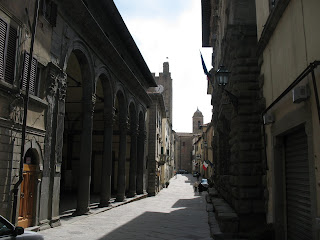
Yet another Tuscan hilltown, this is a waypoint towards Siena that we'd heard much about. Having gotten a late start, we found it pretty much shuttered by the time we arrived hungry for lunch, and were treated to a nice one at a cafe on an old square. There was a bust of poet Giulio Salvadori, who I have not heard of. Apart from an impressive arched loggia across from a massive stone palazzo and a few cow skulls ala Death Valley Days carved into a lintel, there was not much to hold our attention, so we proceeded over the hills and through the woods, through the lovely but somewhat golf-course-like hills outside Siena to:
We were delayed a bit in reaching this goal by getting mired in the goofy road "system" around Siena, but eventually wound through the countryside and up to San G., which despite the off-season weekday was packed with international tourists due to its reputation as an untouched medieval hilltown. The main street, lined with touristy shops, led to a double piazza with one of the town's ancient wells as well as most of its famous towers. Robin headed for the tourist info office and within minutes had amazingly secured the sole tenancy of a palazzo (Casa di Potenti, house of the potent) placed primely on the square, with the caveat that it was directly underneath the giant bells of the cathedral. 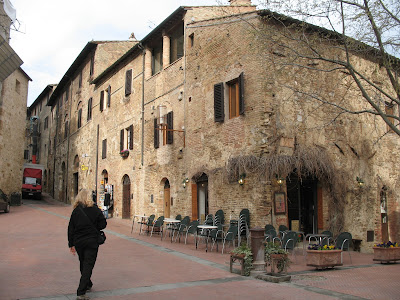
San Gimignano is essentially pedestrian-only except for residents, and the streets are not only extremely narrow and twisting but often dead-end or designated as one-way. Thus to unload our bags from the car meant walking back through town, circumnavigating it, and then taking a maze-like route that would have challenged Theseus, culminating in having to cross the double pizza through a herd of tourists, and then back out again to park. Anyway we spent the day exploring the various churches of course (such as San Agostino), and at dusk circumambulated the ancient fortress, on its olive-tree-covered hill-on-a-hill, for a great view of town and a magenta (!) sunset.
Dined at a restaurant (La Vecchia Mura, the old wall) pretty far off the tourist track, which was patronized by many locals, including a table of about 20 men of varying age who were having a whale of time; it was pure Italy. The old walrus-mustached owner was very nice to the point of being telepathic of our desires. We then spent an interesting night being awoken frequently by the bonging of not the one but two sets of deep church bells about 100 feet away. The first part of the following day was spent breakfasting and walking, as well as climbing up the Large Tower for a panorama of San Gimignano. Sadly we opted to forgo the Museum of Torture.
A few miles on, past an enormous penitentiary placed weirdly in the gorgeous Tuscan hill country (to say nothing of pricey real-estate), we came here on Rick Steves' advice primarily for its Etruscan heritage. Again our first priority was to find lodging, given that it was already mid-afternoon, and, since we'd splurged a bit the previous night, decided to cut costs by sampling the local seminary's offering (also highly recommended by Steves). This was an enormous old building a 15-minute walk out of town; its long, wide, nearly unlit hallways were lined with doors over which old frescoes of the popes peered down. Our door was labeled "Spirituale"; the suite had a peaceful view of a fallow garden and despite being rather decrepit was utterly quiet and provided comfortable haven from the frigid wind which had sprung up. The wardrobe turned out to be full of ledgers dating back to 1702, noting the debits and credits of the staff of the seminary, as well as drafts of letters from the abbot and such -- a wonderful find!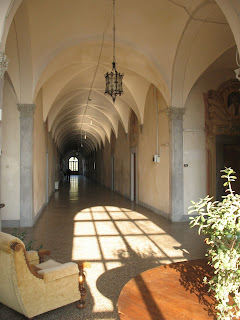
We of course explored the town despite the wind, focusing on the many shops selling handcrafted alabaster items from gewgaws to furniture, sculpture, jewelry, and tableware. (Oddly this town also had a prominent Museum of Torture. And the old Medici fort is used for yet another prison, for maximum-security miscreants.) Dined in an excellent restaurant named Ombre della Sera (Shadow of the Evening) after a mysterious Etruscan sculpture of an elongated figure, and the next day visited the Etruscan Museum, which had three floors of pre-Christian items dug from the local area -- dozens of oblong carved funerary urns (many depicting tales from Homer) as well as the items they contained -- buttons, jewelry, coins, bones, oil lamps, pottery, helmets, weapons, figurines (Ombre della Sera included), etc. On the way out of town we stopped by the Roman amphitheater ruin for some photos.
We promised the kids more beach time so on we went to the Mediterranean, to Puccini's home town (he also shot wildfowl at the local wetland), and where Percy Shelley drowned in the sea and got a piazza named after him. After a bit of searching we found a splendid hotel, La Pace (Peace), on the busy promenade across from the wide, sandy, and syringe-free beach, to which Nick and Piper immediately headed and remained until dinner time. The weather had turned warm again, fortunately. Dined at an unavoidably tourist-filled spot on the promenade, and ordered (and almost finished) far too much food (the frenchfries were the last straw), but met a nice English couple. 
The next morning we went for a walk along the promenade, which is lined with colorful art deco and art nouveau buildings from the heyday of Viareggio's infamous Carnevale mania; we admired the snowy mountains in the distance and discovered a canal along which the local small fishing boats pull up to sell their catch -- baskets full of disturbingly fresh eels, several types of shrimp and prawns, squid, rays, octopus, and shellfish, twitching beside numerous small and colorful fish I didn't recognize. Nearby we discovered an outdoor marketplace with wriggly-tin booths set up under a squad of old and drastically pollarded sycamores, where you could buy everything from clothes to food, trinkets to magazines, housewares -- well, you get the picture. We decided to stay on another night and so passed the afternoon at the beach once again -- watching brave souls wade into the surf to dredge for clams and an old B1 bomber mysteriously drone around and around -- and then after Piper and I walked to a nearby park and watched the geezers playing bocce, treated ourselves to an actual sushi dinner for the first time in three months (trying not to think about the victims at the fish market). Discovered a bookstore that actually had a GOOD selection of books in English, apart from the usual mass-market fodder and olde classics we have typically found. Next morning I took a rainy dawn walk to shoot the shut-up marketplace.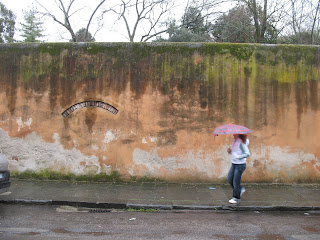
We'd promised/threatened to show the kids the Leaning Tower and so braved the Pisa traffic and absolutely thronging tourists to do so. A good place if you're yearning to hear American accents. Or German. Alas it was raining, and although the tower has now been opened to the public it costs 15 euros a head (!) to climb it, and so all things considered we opted to limit the view to a ground perspective, and concentrated on eating lunch and then moving on. We were serenaded at lunch by a toothless fellow with a guitar and booming baritone -- restaurants seem to have no qualms about letting various types of out-and-out beggars and other entrepreneurs (flower sellers etc.) into their establishments.
Last time we were at this town (as with Pisa) was 1991; Robin had forgotten her camera at a restaurant and miraculously was able to retrieve it via a series of friends, but only after two years! Once more we were directed by tourist info to a nice hotel, the Stipino, slightly outside the ancient wall, and once again we soon found that one night was not enough time to enjoy the town. Lucca is a wonderful place to wander, its lanes deep and shadowy but opening onto many bright piazzas accompanying ornate churches, and a goodly number of parks and even a canal running through it. The centerpiece is a Roman amphitheater which, after serving many later purposes (a prison, for example), was turned in the 19th century into Piazza Mercato, surrounded by towering green-shuttered apartments with cafes and shops at ground level. We dined at a restaurant (Burali) recommended by our hotelier , and as we sat there it dawned on me that it was the same place where the camera had been left! Great waiter, great music (the waiter's compilation) and great food.
The following day started beautifully: we rented bikes and thrice circumnavigated the town atop its wall, enjoying gelato in the Piazza Mercato and lunch before the mosaic facade of Chiesa San Frediano (wherein lies the mummified Santa Zita who fortunately we did not see before we ate). We also climbed the medieval Giungi Tower, with its tiny "garden" at the top, consisting of a couple of ibex trees that are visible for miles around) for a good view of the town in its hill/mountain-surrounded valley. That evening Robin rested while the kids and I walked back into town for a pizza dinner, returning in the rain.
The next morning, storm abated, Robin and I went out while the kids slept, tit for tat, discovering still another church and several squares -- Lucca always seemed to surprise us; I had the best cornetto (croissant) yet. It was now Palm Sunday and folks were out selling palm and olive fronds, and there was a street market by the church where the "foreigners" sold knickknacks. Before we could check out of the hotel, we were captured in our lobby by a guy (from Spokane!) who spent about an hour detailing his past 30 years of teaching biology in Germany and the US, with lengthy detours into his theories of race relations. Yike. Maurizio, the hotelier, nicely gave us a bottle of home-made wine; we sampled it a couple of nights later -- it would have been better to wait about 20 years I think.
Collodi
We headed home to the Molino but zipped into this hillside village briefly to check out the home of Pinocchio's author. There is a highly recommended theme park -- in fact the whole town is rather like a theme park -- but it was expensive and gewgaw-filled enough for us to say phooey and move on. It did have some appealing artwork in the public spaces.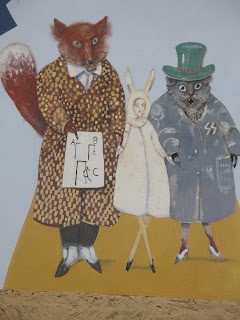
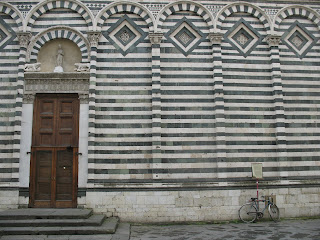
This area is the garden center of Italy, which is to say there are acres (or hectares, whatever those are) of nurseries along the road, featuring everything from flowers, cactus, and shrubbery (all in bloom early, given global warming) to dinosaur topiary, squat little palms, and pointy cypresses. In Pistoia itself we located the Duomo, which compared to Lucca's massive monument seemed pretty modest although it has a really manly campanile, and we had lunch outside in the hot sun beside a church reputed to have "more stripes than any other in Christendom." I did not count. Nearby a local metal band was warming up for a concert in a piazza, with homeless guys looking on. By this time we were getting eager to relax at home so onward we pressed past the traffic horror of Prato, bypassing Firenze, and were in San Giustino by dinner time, where we enjoyed a home-cooked meal for a change, thanks to Robin!
We then had one day to clean house before the arrival of our friend Maggie (our landlady!) from York along with her 11-year-old son Jai, and we are now plotting our last week of adventures.
See you soon,
Sean/Robin/Nick/Piper


